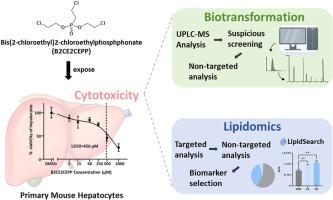双(2-氯乙基)2-氯乙基磷酸酯的生物转化及其对小鼠原代肝细胞脂质分子代谢的影响
IF 8.1
2区 环境科学与生态学
Q1 ENVIRONMENTAL SCIENCES
引用次数: 0
摘要
双(2-氯乙基)2-氯乙基磷酸酯(B2CE2CEPP)最近被报道为地下水样品中的污染物,然而,关于其生物转化和不良影响的信息相对较少。在本研究中,B2CE2CEPP和三(2-氯乙基)磷酸(TCEP;以一种与B2CE2CEPP结构非常相似的典型有机磷三酯为目标污染物,通过体外原代肝细胞实验,比较研究了它们的细胞毒性、生物转化和脂质代谢的改变。本研究旨在深入研究B2CE2CEPP和TCEP对ICR小鼠原代肝细胞的细胞毒性、生物转化和脂质代谢作用,揭示这两种有机磷化合物的潜在健康风险。结果表明,B2CE2CEPP和TCEP均具有细胞毒性,LC50值分别为456 μM (B2CE2CEPP)和1250 μM (TCEP)。暴露于小鼠原代肝细胞(PMHs)后,这两种化合物都发生了显著的代谢转化,基于高分辨率轨道阱质谱技术,共鉴定出4种潜在的代谢物。暴露于TCEP和B2CE2CEPP导致PMHs脂质代谢紊乱。TG(16:0/16:1/18:1)对B2CE2CEPP暴露表现出较高的敏感性,并呈显著上调趋势,是受B2CE2CEPP暴露显著影响的潜在生物标志物。脂质组学分析表明,B2CE2CEPP影响脂质代谢途径,包括硫胺素代谢、叶酸碳库和叶酸类固醇激素的生物合成。本研究填补了目前对B2CE2CEPP生物转化和不良影响研究的知识空白,强调了在各种环境样品中对B2CE2CEPP及其结构样化合物进行一致性监测的重要性。本文章由计算机程序翻译,如有差异,请以英文原文为准。

Biotransformation of bis(2-chloroethyl)2-chloroethylphosphphonate, and its effects on metabolism of lipid molecules in primary mouse hepatocytes
Bis(2-chloroethyl)2-chloroethylphosphphonate (B2CE2CEPP) was recently reported as a contaminant in underground water samples, however, information regarding its biotransformation and adverse effects is relatively rare. In this study, B2CE2CEPP and tris(2-chloroethyl) phosphate (TCEP; a typical organophosphate triester with a very similar structure as compared to B2CE2CEPP) were used as target contaminants to comparatively investigate their cytotoxicity, biotransformation, and alteration of lipid metabolism by use of an in vitro primary hepatocyte assay of ICR mice. This study aims to thoroughly investigate the cytotoxicity, biotransformation, and lipid metabolism effects of B2CE2CEPP and TCEP on primary hepatocytes of ICR mice, in order to reveal the potential health risks of these two organophosphorus compounds. The results showed that both B2CE2CEPP and TCEP were cytotoxic with LC50 values of 456 μM (B2CE2CEPP) and 1250 μM (TCEP), respectively. Both compounds underwent significant metabolic transformation follow exposure to primary mouse hepatocytes (PMHs), and a total of 4 potential metabolites were identified based on high-resolution orbitrap mass spectrometry technique. Exposure to TCEP and B2CE2CEPP led to lipid metabolism disorders in PMHs. TG (16:0/16:1/18:1) showed high sensitivity to B2CE2CEPP exposure and exhibited a significant upregulation trend, making it a potential biomarker significantly influenced by B2CE2CEPP exposure. Lipidomic analysis showed that B2CE2CEPP affected lipid metabolic pathways including thiamine metabolism, one carbon pool by folate, and folatesteroid hormone biosynthesis. The present study filled a knowledge gap in the current research on the biotransformation and adverse effects of B2CE2CEPP, and emphasized the importance on consistent monitoring of B2CE2CEPP and its structure-like compounds in various environmental samples.
求助全文
通过发布文献求助,成功后即可免费获取论文全文。
去求助
来源期刊

Chemosphere
环境科学-环境科学
CiteScore
15.80
自引率
8.00%
发文量
4975
审稿时长
3.4 months
期刊介绍:
Chemosphere, being an international multidisciplinary journal, is dedicated to publishing original communications and review articles on chemicals in the environment. The scope covers a wide range of topics, including the identification, quantification, behavior, fate, toxicology, treatment, and remediation of chemicals in the bio-, hydro-, litho-, and atmosphere, ensuring the broad dissemination of research in this field.
 求助内容:
求助内容: 应助结果提醒方式:
应助结果提醒方式:


